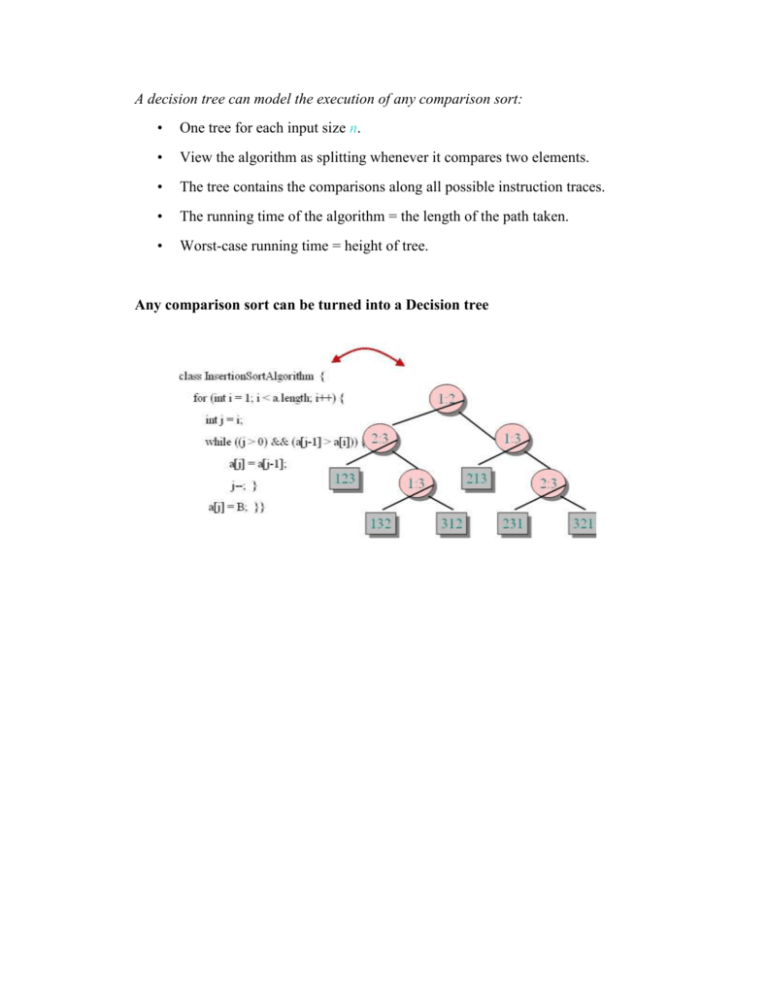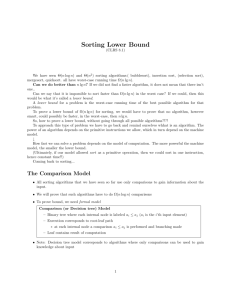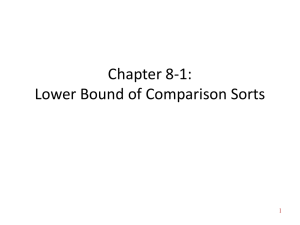Any comparison sort can be turned into a Decision tree
advertisement

A decision tree can model the execution of any comparison sort: • One tree for each input size n. • View the algorithm as splitting whenever it compares two elements. • The tree contains the comparisons along all possible instruction traces. • The running time of the algorithm = the length of the path taken. • Worst-case running time = height of tree. Any comparison sort can be turned into a Decision tree Decision Tree Model • In the insertion sort example, the decision tree reveals all possible key comparison sequences for 3 distinct numbers. • There are exactly 3!=6 possible output sequences. • Different comparison sorts should generate different decision trees. • It should be clear that, in theory, we should be able to draw a decision tree for ANY comparison sort algorithm. • Given a particular input sequence, the path from root to the leaf path traces a particular key comparison sequence performed by that comparison sort. - The length of that path represented the number of key comparisons performed by the sorting algorithm. • When we come to a leaf, the sorting algorithm has determined the sorted order. • Notice that a correct sorting algorithm should be able to sort EVERY possible output sorted order. • Since, there are n! possible sorted order, there are n! leaves in the decision tree. • Given a decision tree, the height of the tree represent the longest length of a root to leaf path. • It follows the height of the decision tree represents the largest number of key comparisons, which is the worst-case running time of the sorting algorithm. “Any comparison based sorting algorithm takes Ω(n logn) to sort a list of n distinct elements in the worst-case.” – any comparison sort ← model by a decision tree – worst-case running time ← the height of decision tree “Any comparison based sorting algorithm takes Ω(n logn) to sort a list of n distinct elements in the worst-case.” • We want to find a lower bound (Ω) of the height of a binary tree that has n! Leaves. ◊ What is the minimum height of a binary tree that has n! leaves? • • The binary tree must be a complete tree (recall the definition of complete tree). • Hence the minimum (lower bound) height is θ(log2(n!)). log2(n!) = log2(n) + log2(n-1) + …+ log2(n/2)+…. ≥ n/2 log2(n/2) = n/2 log2(n) – So, log2(n!) = Ω(n logn). n/2 • It follows the height of a binary tree which has n! leaves is at least Ω(n logn) ◊ worstcase running time is at least Ω(n logn) • Putting everything together, we have “Any comparison based sorting algorithm takes Ω(n logn) to sort a list of n distinct elements in the worst-case.” Adversary Arguments Adversary argument: a method of proving a lower bound by playing role of adversary that makes algorithm work the hardest by adjusting input Example: “Guessing” a number between 1 and n with yes/no questions Adversary: Puts the number in a larger of the two subsets generated by last question Lower Bounds by Problem Reduction Idea: If problem P is at least as hard as problem Q, then a lower bound for Q is also a lower bound for P. Hence, find problem Q with a known lower bound that can be reduced to problem P in question. Example: Euclidean MST problem • Given a set of n points in the plane, construct a tree with minimum total length that connects the given points. (considered as problem P) • To get a lower bound for this problem, reduce the element uniqueness problem to it. (considered as problem Q) • If an algorithm faster than n log n exists for Euclidean MST, then one exists for element uniqueness also. Aha! A contradiction! Therefore, any algorithm for Euclidean MST must take Ω(n log n) time.






